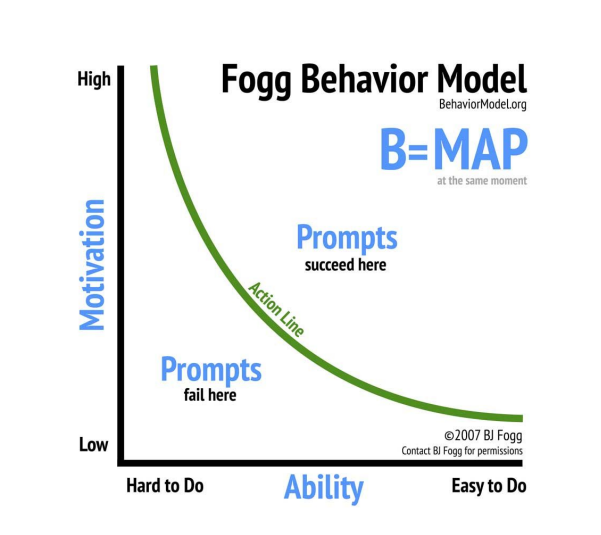With the introduction of websites to the internet, marketers have been working tirelessly to develop strategies for influencing user behavior and driving conversions.
As professional marketers, we know that one of the most critical factors in any marketing campaign is conversion and this can be anything you’d like users to accomplish, as the main goal (a product sold, a booking completed, a phone call, lead).
Now, there is something we need to know. No formula, framework, or methodology is to work 100% in all cases (the random nature of humans will have that degree of unpredictability, always!) and there are more than one ‘school of thought’, each of them proposing variations of the same formula. So, is there a way to get an overall understanding of what is needed to get a sale, lead, booking in every single scenario, no matter how small or gargantuan?
Dr. BJ Fogg, a behavioral scientist at Stanford University, proposes through the “Fogg Behavior Model” that behavior change occurs when three elements are present: motivation, ability, and triggers.
The Fogg Behavior Model has gained widespread popularity among marketers and product designers as a tool for understanding user behavior and creating effective products and marketing campaigns.

The three elements of the Fogg Behavior Model are defined as follows:
- Motivation: This refers to a person’s level of desire or willingness to perform a behavior. A person may be motivated to do something if it aligns with their goals, values, or desires. Motivation can be influenced by a range of factors, including emotions, social norms, and personal beliefs.
- Ability: This refers to a person’s capability to perform a behavior. In order to increase conversion rates, it is important to make sure that visitors have the ability to take the desired action, such as by providing clear instructions or access to the necessary resources. Otherwise, we present them with a compelling offer but provide a messy path forward that they are unable to complete. Ability can be influenced by factors such as time, resources, and physical or cognitive limitations.
- Triggers: This refers to the stimuli that prompt a person to perform a behavior. Triggers can be internal or external, and they can be classified into three types: time-based, action-based, and emotion-based.
- Time-based triggers occur at a specific time or frequency,
- Action-based triggers occur after a specific action is performed, and
- Emotion-based triggers occur in response to a certain emotional state.
According to the Fogg Behavior Model, behavior change occurs when all three elements – motivation, ability, and triggers – are present at the same time. For example, a person may be motivated to start exercising, but if they don’t have the ability (e.g., access to a gym or equipment), they are unlikely to follow through. Similarly, a person may have the ability to perform a behavior, but without the right trigger, they may not be motivated to do so.
Furthermore, Dr. McGlaughlin as the Managing Director and CEO of MECLABS proposed “The heuristic conversion formula”, a framework that helps marketers understand how to optimise their conversion rates by focusing on the key elements that drive customer decision-making. The formula is broken down into several key components, each of which represents a critical step in the customer journey: The overall probability of conversion (C) is calculated by factoring in the motivation of the customer (m), the clarity of the value proposition (v), the level of friction in the buying process (f), the level of anxiety experienced by the customer (a), and the level of incentive (i) required to complete the conversion.

As we can see on the image, the first component of the formula, “4m”, refers to the level of motivation that a prospect has to complete the desired action. This can be influenced by factors such as the perceived value of the offer, the level of urgency, and the relevance of the messaging. Your users’ motivation is something that you can’t manipulate or influence, but you can still optimize your sales page content to appeal to their existing motivations and increase your conversion rates.
The second part of the formula, which is “3v”, refers to your value proposition. The perceived value of the offer compared to the prospect’s perceived cost of taking the desired action. This component refers to how effectively the sales copy communicates the unique benefits and features of the product or service being offered. A clear value proposition can help differentiate your product from the competition and make it more attractive to potential customers.
“i” refers to incentives, and incentives are basically any special offers, discounts, or other things that may motivate the customer to take action.
“f” alludes to the level of friction that a user has at the time of completing a purchase. These things can be as basic as a complicated checkout process, unclear instructions, or any other roadblocks that may discourage customers. That’s why it’s so important to be clear with your copy.
The last component of the formula “2a” refers to the level of anxiety experienced by the customer. Making a decision always involves considering the potential risks, costs, and benefits involved. To encourage conversions, you need to make sure that you address those anxieties and that you eliminate them so that the user feels confident moving forward.
Marketers can use the Fogg Behavior Model and the conversion optimisation heuristic formula proposed by MECLAB´S to design products and campaigns that effectively influence user behavior. By analysing each of these components and identifying areas for improvement, businesses can develop data-driven strategies for optimising their sales and marketing efforts and driving conversions.

